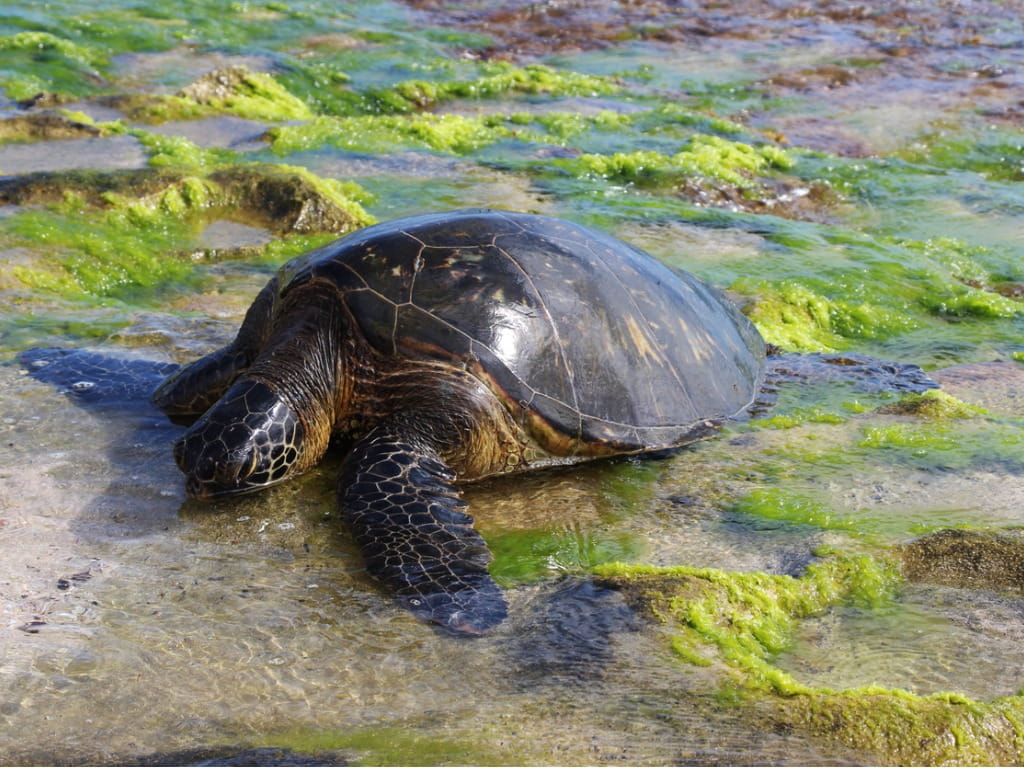Is Sea Turtle Meat Poisonous?

The Bottom Line
Chelonitoxism is a rare and potentially life-threatening disease that occurs due to consumption of contaminated sea turtle meat. There is no known antidote for chelonitoxism, but the disease can be prevented by avoiding the consumption of raw or cooked sea turtles.

The Full Story
Harmful algal blooms, caused by the uncontrolled growth of algae species, can occur in marine or freshwater environments. The toxins produced by the rapidly proliferating algae are associated with the development of multiple foodborne illnesses including shellfish poisoning and ciguatera fish poisoning. In freshwater environments, cyanobacteria (also known as blue-green algae) produce toxins that can affect the human nervous system, liver, and other organs. When humans come into contact with water contaminated with cyanobacteria, symptoms including abdominal pain, nausea, vomiting, and headache can occur. Skin exposure to cyanobacteria can cause rashes, blistering, and itching.
There are thousands of cyanobacteria species that live in in the seagrass and sandy areas of Hawaii, Australia, and other tropical locations. When fish and other aquatic life feed on cyanobacteria, the bacteria remain within their bodies and can be detected in muscle, skin, and other organs. When humans eat fish affected by cyanobacteria, undesirable signs and symptoms can occur. In Hawaii, human consumption of seaweed contaminated with cyanobacteria has caused severe mouth pain and ulcerations in some individuals.
Another type of poisoning believed to be related to cyanobacteria is called “chelonitoxism” and occurs after consumption of contaminated sea turtle meat. This is a rare disease that most commonly occurs in Indo-Pacific countries such as Madagascar and the Philippines. Even though sea turtles are an endangered species protected by international regulations that prohibit both the hunting and human consumptions of these species, mass outbreaks of chelonitoxism continue to occur, often in the context of group celebrations. Affected turtles appear healthy and do not exhibit signs of illness, but human poisoning can occur if the turtle meat is cooked, eaten raw or boiled in soup, and all parts of the turtle are potentially toxic. Green sea turtles and hawksbill turtles are most commonly implicated in cases of chelonitoxism, but poisoning can also occur after the ingestion of other turtle species. Common initial symptoms occur within a few days of eating the turtle meat and include itching and pain in the mouth and throat, vomiting, and abdominal pain. Mouth and tongue ulcerations may also be present, and some individuals may develop neurologic disturbances such as confusion, seizures, or coma. Survivors can have permanent disabilities including paralysis, and death may occur in severe cases of poisoning. Children are especially susceptible to this type of poisoning, and the toxin can be passed in breast milk from a mother to her infant. Pets have also died after eating contaminated sea turtle meat or the vomit of affected humans.
Because the signs and symptoms of chelonitoxism are similar to those of other types of food poisoning such as ciguatera, the diagnosis can be challenging to establish. There is no antidote for chelonitoxism, as the specific toxins responsible for the illness have not been identified. While treatment generally involves symptomatic or supportive care with intravenous fluids, electrolyte replacement, and respiratory support, advanced medical care is often not available in the regions where outbreaks tend to occur. In addition, some individuals affected by chelonitoxism may be afraid to seek medical care due to fears of prosecution related to their illegal consumption of turtle meat. These reasons may be responsible for the relatively high mortality rates noted in recent outbreaks of chelonitoxism.
If you suspect food poisoning, get help online or call 1-800-222-1222. Both options are free, and available 24 hours a day.
Kelly Johnson-Arbor, MD
Medical Toxicologist
Poisoned?
Call 1-800-222-1222 or
Prevention Tips
- Do not eat sea turtle meat, even if it is cooked.
- Seek medical attention immediately if you develop numbness, tingling, or itching in your mouth after eating seafood.
- When traveling away from home, maintain an awareness of local and international regulations pertaining to protected plant and animal species.
This Really Happened
In November 2021, 45 people living on an island off the coast of Tanzania were hospitalized after eating sea turtle meat, which is considered a delicacy in that country. Affected individuals developed symptoms the day after eating the turtle meat. Seven people, including a three-year-old child, died within days of consuming the turtle. Most of the other victims recovered and were able to be quickly discharged from the hospital, but 3 of the victims remained hospitalized for several days after the initial symptoms appeared.For More Information
BBC News. Tanzania: seven die in Zanzibar after eating poisonous turtle meat [accessed 12.17.21].
References
Poisoned?
Call 1-800-222-1222 or
Prevention Tips
- Do not eat sea turtle meat, even if it is cooked.
- Seek medical attention immediately if you develop numbness, tingling, or itching in your mouth after eating seafood.
- When traveling away from home, maintain an awareness of local and international regulations pertaining to protected plant and animal species.
